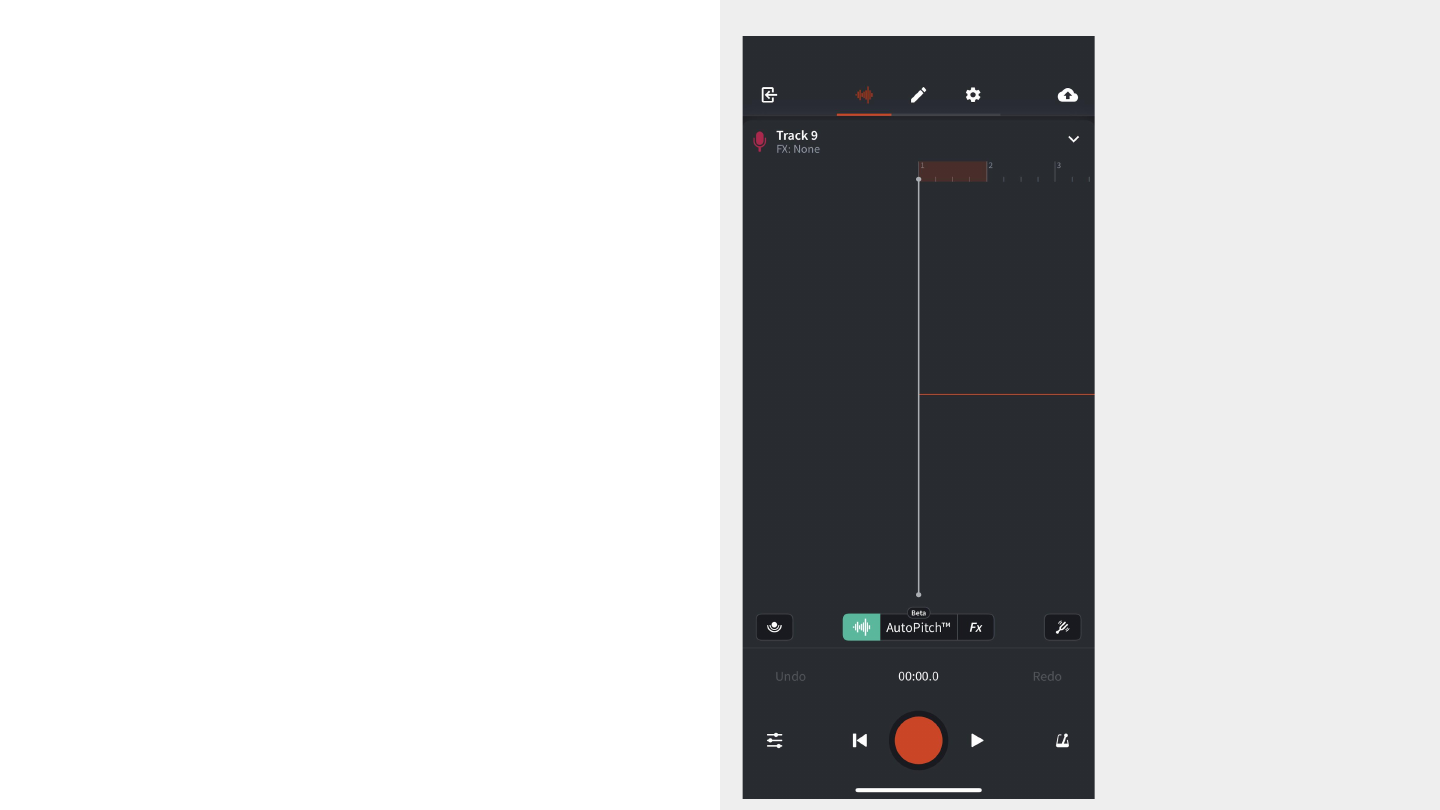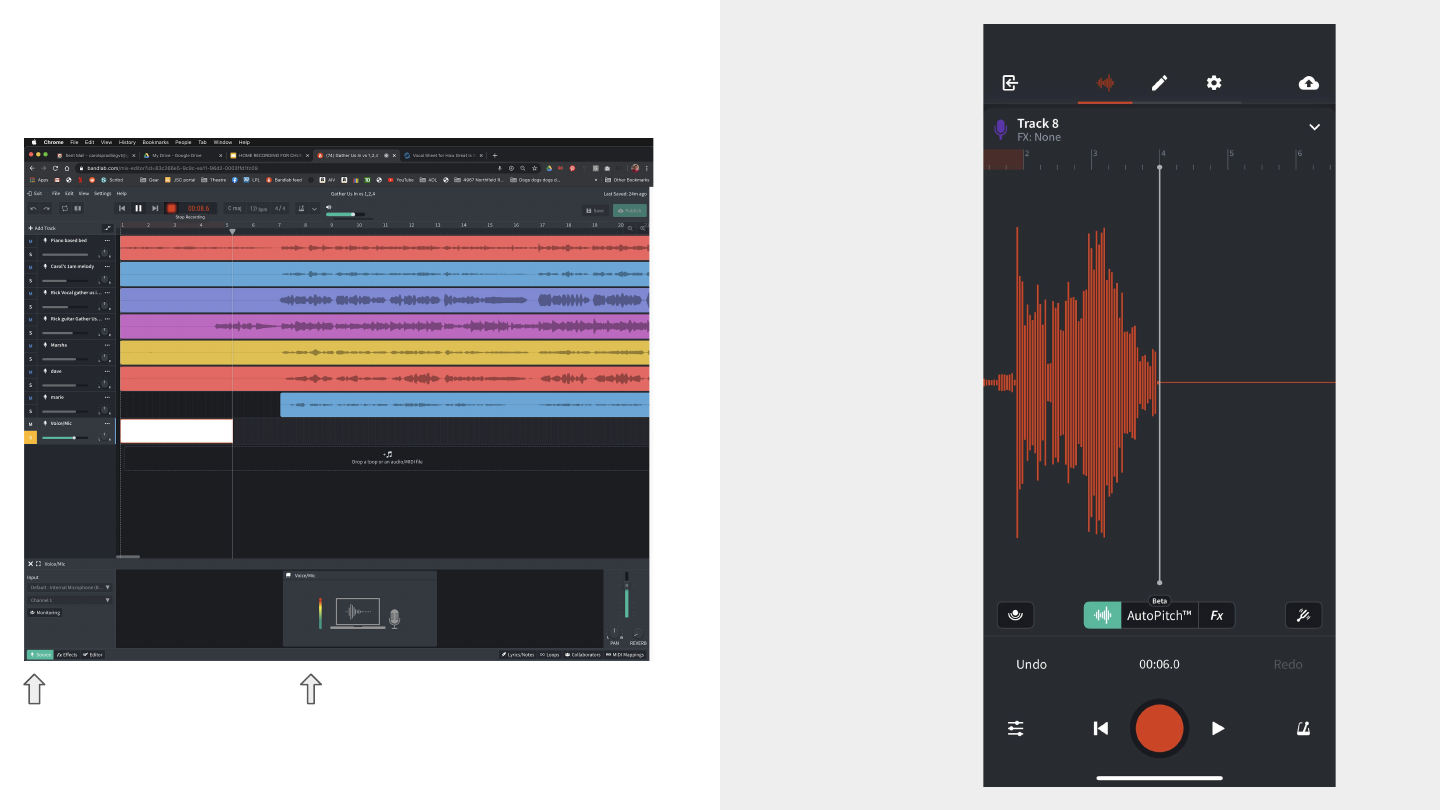
VIRTUAL CHOIR
for
THE REST OF US
Carol Spradling
Music Director,
First Congregational Church of Essex Junction, VT
1

OVERVIEW: TOPICS
EQUIPMENT
What you (director) will need
What they (choir/musicians) will need
Hardware Components:
- Keyboard(s)
- microphone(s)
- Audio interface
- Cables: MIDI, XLR, TRS
- Desktop, mobile device
Software -
- DAW (director)
- BandLab (director; choir)
MIDI vs audio
BandLab app/interface (mobile & desktop)
Mastering and troubleshooting: sync, intonation,
dynamics
2

1
Director lays down
accompaniment tracks
Direct into BandLab or into DAW mixed
down into BL.
2
Get music to singers and
rehearse over Zoom
Write in your breathing plan, dynamics,
other interp details, before sending PDF.
(CameraScan)
3
Singers record their tracks
Teach them how to record; give them a
deadline
4
Director adds mastering
(reverb, EQ) and mixes down
MP3 sent to worship team for inclusion in
worship webcast
WORKFLOW VISUAL
3

1
Director lays down
accompaniment tracks
Direct into BandLab or into DAW mixed
down into BL.
ANATOMY OF A DIRECTOR TRACK
● ACCOMPANIMENT = leads the interpretation;
precise
● VOCAL PARTS = I record every note of the
vocals. This is omitted in final mix.
● Play it the way you want it! Precise cutoffs,
rhythm, diction.
● CLICK TRACK = to keep the rhythm precise and
clean. Don’t rely on BL’s metronome, because it
can be changed inadvertently by group
members (or turned off). To be reliable and
accurate, this is created as a MIDI file using a
percussion voice.
4

2
Get music to singers and
rehearse over Zoom
Write in your breathing plan, dynamics,
other interp details, before sending PDF.
(CameraScan)
ANATOMY OF A ZOOM REHEARSAL
Audio setting: Enable original sound
● EVERYONE IS MUTED once singing starts (not yet
possible to “sing together” on Zoom)
● PLAY TRACK THROUGH ZOOM. Play piano through
your computer audio (Audio Interface) rather than
acoustically - less lag, purer sound
● TALK THRU TRANSITIONS
● I start with prayer and warmup, and we end with
social gathering
Don’t forget security! Password, waiting room, require
authentication
5

3
Singers record their tracks
Teach them how to record; give them a
deadline
RECORDING TIPS FOR SINGERS
● USE MOBILE DEVICE NOT COMPUTER WHEN STARTING
OUT: Better microphones, easier interface, lower latency
● WARM UP FIRST. There are literally hundreds of YouTube
vocal warmups. Pick one and do this for five minutes.
You’ll like the results!
● LISTEN BEFORE YOU RECORD: Listen to the entire
accompaniment bed while following along in your music to
make sure you are comfortable
● DO A SOUND CHECK: The only way to make sure you are
set up properly is to test it out first
● ACCEPT YOUR VOICE: Director doesn’t want an AutoTuned
studio performance - she wants YOUR voice.
● BE PATIENT: You can do this. If it’s all new to you, do what
you can. Ask for help and trust in God.
6

4
Director adds mastering (reverb,
EQ) and mixes down
MP3 sent to worship team for inclusion in
worship webcast
POST PRODUCTION
● AREAS YOU’LL WANT TO ADDRESS: Sync, EQ, intonation,
vocal presence - all of these can be “fixed in post”.
● START SIMPLE: Give yourself permission to be a beginner
at this, and let go of the inner critical voice.
● FOCUS FIRST ON UTILITY: Does the hymn encourage
singing at home, if that is an outcome your worship team
desires? If not, what adjustments can be made?
● DON’T DO IT ALL YOURSELF: Get a choir member or two
up to speed on the tech, particularly BandLab for the
singers, so you can focus on putting it together. As
Sondheim wrote… “Bit by bit.. Putting it together…”
● BE PATIENT WITH SELF AND PROCESS: Like anything else,
this gets easier and works better, with practice.
7

There are many
many ways to
achieve the same
thing...
8

PART ONE:
DIRECTOR
9

TOOLS NEEDED: DIRECTOR
● Keyboard
● MIDI-to-USB interface (for older models)
● Computer
● BandLab software
● Microphone/headphones
● (Digital) Audio Interface
● External DAW for post-production/mixing
10

Framework for each workflow component
4 ways of achieving the goal, from free to expensive, from basic to advanced....
YOU CAN… BUT DON’T
(or, try not to…)
Examples might be jury-rigging cables, using headphones as
a mic, trying to record audio of your pipe organ as
accompaniment, your PC’s onboard mic, etc.
BASIC BUT FINE Most accessible with the least amount of investment or
know-how required, but still possible to achieve adequate
result. Choir members can live here.
INTERMEDIATE Next steps in refining more favorable outcomes, especially
for director use. Invest in what you can. Church
reimbursement… fund-raise… schedule C…
ADVANCED Generally speaking, good equipment and more know-how
than “Intermediate”; will happen over time.
11

EQUIPMENT/
TOOLS:
a closer look
12

DIGITAL/MIDI
KEYBOARD
I found this insane deal. Includes extras that can
add up: piano stand, speaker, music stand,
bench, and full weighted keyboard. $400 for an
Alesis “Clavinova”!!
13

KEYBOARD: 4 LEVELS
YOU CAN… BUT
DON’T
(or, try not to…)
Acoustic piano - or organ -
recorded acoustically (with
external microphone)
Leave this to recitals. Going to have audio issues (room noise,
mic quality)… Frustrating because we love our Steinways and
pipe organs… but not best for clean, accurate track that singers
need for precision.
BASIC BUT FINE
Electronic keyboard
recorded as audio from
headphone output
You will need a digital audio interface. Don’t forget keyboard
stand, music stand, speakers, cables, bench. Will need
adaptor/splitter if using headphone output (¼” balanced cable
required). Output will be mono unless splitter is used.
INTERMEDIATE
MIDI from thrift store Casio
into BandLab direct
Basic sounds; no visual (WYSIWYG) editing; need a MIDI editor
for imported file and notation software for printed edits
ADVANCED
MIDI recorded using full
(professional) weigtdigital
keyboard (Korg, Roland,
Nord, Yamaha)
The better the keyboard Digital audio interface not needed for
modern (USB midi) keyboards. MIDI interface required for older
5-pin MIDI (interface transmits MIDI from 5-pin to USB input on
computer)
14

KEYBOARD (for virtual choir): 4 LEVELS
YOU CAN… BUT
DON’T
(or, try not to…)
Acoustic piano - or organ -
recorded acoustically (with
external microphone)
Leave this to recitals. Going to have audio issues (room noise,
mic quality)… Frustrating because we love our Steinways and
pipe organs… but not best for clean, accurate track that singers
need for precision. You’ll need a digital audio interface (DAI)
BASIC BUT FINE
ANY Electronic keyboard,
including thrift store Casio,
recorded as audio from
headphone (stereo) output
You will need a DAI. Will need adaptor/splitter if using
headphone output (¼” balanced cable required). Output will be
mono unless splitter is used.
INTERMEDIATE
MIDI from ANY keyboard,
into BandLab direct or DAW
MIDI beats audio hands down. Basic sounds; no visual
(WYSIWYG) editing; need a MIDI editor for imported file and
notation software for printed edits. No DAI needed for MIDI but
MIDI-to-USB interface cable to be used for old-style MIDI output.
ADVANCED
MIDI recorded using full
(professional) weigtdigital
keyboard (Korg, Roland,
Nord, Yamaha), particularly
those with USB MIDI
USB MIDI requires no interface of any kind. Better keyboards
will allow virtuosic performances while sacrificing no precision.
15

MIDI
Old style (5 pin) MIDI connection:
- Connects to USB using a USB-to-MIDI cable or hub
- Input into USB port on your device using MIDI-to-USB cable
- No digital audio interface required (but playback audio will
need to be routed from your keyboards audio output to
speakers)
16

MIDI - whazzit?
A non-technical (user) perspective
MIDI is not sound. It is a series of commands, like computer
code, that tell a sound-producing instrument (keyboard or
computer) how to produce sound.
Thus, when you play a MIDI keyboard into a MIDI recorder like
GarageBand, you are essentially “typing”. Computer receives what
you type and turns into sounds and into printed music.
17

MIDI VS AUDIO
RECORDING
Audio track, aka Attack of the Blobs
MIDI track (note built in score editor; highly
editable and versatlie)
Same song, recorded at the same
time, 2 formats… 2 results
18

MIDI vs AUDIO RECORDING
MIDI
● The voices/sounds are generated by
your software, not your keyboard
● MIDI (5 pin) or USB port on keyboard
● Produces both sound and printable
score
● You “type from the keyboard”...
● Or there are vast libraries of MIDI
files on ChoralWiki, of varying quality
● Editable - hit a wrong note, change it
after
● $400 Casio from WalMart just as
good as my $4500 Nord Stage 3
● Use digital audio interface for lag
issues
● Go beyond solo piano! Play pipe
organ, or add a clarinet solo, or drum
track…
AUDIO
● Using audio out (L/R) ports from back of
your keyboard. ¼” “guitar cables”
● These go into a DIGITAL AUDIO
INTERFACE (next section)
● Audio Interface connects to USB port of
computer
● The voices are generated on board your
keyboard
● Better keyboards (Clavinova, etc.) will
have better keyboard sounds than starter
MIDI voices… solo piano music recorded
as performance would be better audio
● MIDI better for recording or for
multi-timbral (“patches”) performance like
modern musical theater
19

“Found” MIDI files (e.g. ChoralWiki)
There is a wealth of MIDI public domain music - some basic, some terrible, but many
are very good as at least a starter template
If you are not a keyboard player, or do not have a keyboard...
20

Common music formats
MIDI: A common language between printed musical language
and musical sounds. Import into music publishing software or
desktop audio workstation
MUSIC XML: Newer language, more geared toward printed
page. Functions as “smart PDF”. Can import into DAW with
more limitations than MIDI.
PDF: “Dumb” printed music - dots on a page. Can you scan into
editable music form? Answer: sorta.
21

RECORDING
SOFTWARE
BandLab
mobile
interface
(iPad pro
12.9”)
Desktop UI of BandLab (bandlab.com)
22

SOFTWARE (DAW) for director: 4 LEVELS
YOU CAN… BUT DON’T
(or, try not to…)
Any old, out of date software
on your Windows 98
computer….
… or your phone’s Voice Memos
BASIC BUT FINE BandLab (for production) Free! Limitations: virtual instruments,
12 track limit, very limited
post-production.
INTERMEDIATE GarageBand, Cakewalk(which
is BandLab), LMMS, other free
software.
Cute, easy, cheap, great way to get
started and go to the next level beyond
BL.
ADVANCED Professional DAW: Logic Pro,
Ableton Pro Tools, Adobe
Audition, dozens more
Many more MIDI sounds and robust
features. Expandable through vast
universe of samples and plugins
(Melodyne, Kontakt, etc). Includes MIDI
editing, score editing, audio production
23

DAWs - a sample list
Free: Cakewalk, Audacity (audio only), LMMS, GarageBand*
Paid/professional: Cubase, Audition, Ableton Live, Pro Tools,
Logic Pro*
24
Mac only

MICROPHONES
Shure SM-58, the Dunkin Donuts of vocal
mics (as in, they’re everywhere, they’re
cheap, and they’re perfectly adquate)
25

MICROPHONES
Record a vocal track. Even if you’re not a “singer”, you
want to lay out phrasing, articulation, and other
performance conventions in a way that only
demonstration can.
You also want to know first hand what it feels like to
record vocals, to better assist choir members.
26

MICROPHONES: 4 LEVELS
Mic built in to desktop/laptop, or mic
inserted into PC headphone jack.
YMMV. Most not built for music. Quality and lag issues.
If external mic is plugged in, need a splitter and a digital
audio interface.
Direct into phone or mobile device Acceptable quality. Limited control over gain/noise.
Cost: free
USB microphone or dynamic (SM58) USB mics have an onboard audio-to-digital converter
for plugging directly into computer (so no DAI needed).
Cost: inexpensive $15 to moderate $150. Dynamic mic -
(SM58 type) - ideal for live sound, decent for recording.
Less sensitive than condensor. Requires DAI.
Large-diaphragm condenser mic Larger condensor mics (“soda can”) ($200 and up)
require phantom power but can reproduce virtually
flawless human voice. Requires Digital Audio Interface.
VERY sensitive - so best for very quiet recording
environment. Need closed back headphones.
27

MICROPHONES: ROOM and HANDLING
Mics are sensitive. They will pick up the tiniest sound from
movement, and “room noises”.
Must not hold mic - use a mic stand. If needs be, put mic on a
surface and record. If using phone, put on a cloth surface (towel
on a desk is fine).
Rooms have sounds of their own - electrical hum, reflective
surfaces. Low priced “isolation booth” can solve.
28

DIGITAL AUDIO
INTERFACE
Focusrite Scarlett 2i2 ($160). They
make a “solo” but it’s only $50 less and
you will want that second input!
29

DIGITAL AUDIO INTERFACE
The DAI does the work of converting analog (sound) to digital
(0s an 1s), so your CPU doesn’t have to. Also acts as a pre-amp
(boosting signal), and provides phantom power to professional
microphones.
Come with software plug-ins to aid recording quality.
Cost: plan for about $100 for a good used 2-channel AI to get
started with.
30

HEADPHONES
WIRED FOR SOUND
ANY HEADPHONES WILL DO AS
LONG AS THEY HAVE ONE OF THESE
31

HEADPHONES (AKA CANS): 4 LEVELS
Wireless, no matter how fancy Do not use. Bluetooth lag will mean recorded vocals will
not sync up.
Cheapo (wired) Literally can be less than $10. As long as you can hear
the accompaniment while you sing, good to go. Check
“bleed” during sound check (required).
Quality ear buds (wired) Pro: less cumbersome. Allows singer to hear more of
own resonance. Con: bleed with sensitive mic
Quality “cans” (over ear “closed-back”) -
wired (a must if using higher end
condensor type mics, which will pick up
“bleed” from open type cans
Pro: Cover the ear to keep sound in. Con: trained singers
(like me) HATE wearing cans because they cancel our
ingrained proprioceptic signals. Can put all signal in one
ear and only wear one side…
32

VIRTUAL CHOIR using BANDLAB
A choral singer’s guide to hardware and
software
Carol Spradling, Director of Music
First Congregational Church of Essex Junction, VT
33

Introduction
As of June 2020, we have been told that singing could be dangerous as far as spreading a virus. We voice teachers know that
makes perfect sense. When you all sing the way we’ve taught you - from your diaphragm - the athletic action propels forth a
LOT of air. Until it has been deemed safe, many of us will be unable to sing together in worship. This project - a virtual choir -
helps feed everyone’s soul in the meantime.
I use a service called BandLab, which allows singers to record their parts into an online project. To keep it simple, I use audio
only (not video). I create the foundations of the project (the accompaniment or “bed”), singers add to it, and I mix it down to
create a final mp3, which is uploaded to the church and included in our online worship service.
My process is not perfect (I decided long ago to let go of the perfect and seek instead the good.) And it’s not effortless - both my
singers and myself have put countless hours into these recordings. At first, the recordings were a bit messy, as we all learned
how to use the technology. But now, we are able to create high-quality hymns and anthems fairly quickly. The music has been
nothing short of mind-blowing to our community members, who have shared deep and meaningful connections to what the
music has meant to them.
Please join me and thank, in your hearts, for a moment, the choir members of a little town outside Burlington, Vermont. When
we started all of this, the snow was still falling onto our empty ski slopes. Now our Green Mountains are green again, and the
choir is taking a well-deserved haitus for some fresh air. Their work, and the headaches we all solved together, have helped me
create this guide to steer you clear of some stuff that left us head-scratching and stumped.
Enjoy the singing, keep the goal in mind… soli Deo gloria!
Carol Spradling
Essex Junction, VT
34

TOOLS NEEDED: CHOIR MEMBER
1. Something to record into - a laptop, desktop, phone, or tablet
2. A microphone (if using phone/tablet, internal mic is fine… desktop/PC requires external USB mic
(only this mic can be used directly into PC without adding a digital audio interface). Don’t forget the mic
stand.
3. WIRED headphones (wireless, no matter how fancy and expensive, will have lag issues and your
voice will not sync to the recording). Headphones ideally need to be closed (“cans”) so that sound does
not bleed from phones into microphone.
(Additional gear if desired)... a digital audio interface, XLR dynamic or condenser mic, desktop digital
audio workstation (DAW) (Audacity, GarageBand, or professional apps like Pro Tools, Logic, Ableton Live).
Don’t forget the mic stand if using an external mic.
FOLKS - YOU CAN DO THIS ENTIRE PROJECT, quite successfully, WITH JUST YOUR CELLPHONE!!
35

WORKFLOW: CHOIR MEMBER
YOU CAN… BUT
DON’T
(or, try not to…)
Laptop/Desktop using
onboard mic, or external
(non-USB) mic without
audio interface.
Lag issue with internet (cloud-based) web recording,
most computer mics are barely adequate for spoken
word. NON-USB mics require the use of an external
digital audio interface (not required with USB mics)
BASIC BUT FINE
Apple or Android phone or
tablet - EASIEST BY FAR.
Using on-board mic… these mics are far better than computer,
and the recording is housed locally (on the device). iOS = ZERO
lag. Android = lag varies. Most of my singers do this.
INTERMEDIATE USB mic (Blue Yeti) Primarily made for podcast/spoken word, step up from
built in phone mic. Use with mobile version not desktop
(lag). No audio interface needed.
ADVANCED
Similar to director’s rig,
professional (XLR) mic to
digital audio interface
Great equipment, but watch for mic sensitivity (requires
closed-back headphones). Best result by recording into local
DAW then uploading to BL. Only one of my singers does this, and
he’s an engineer and audio geek.
36

BandLab
What is it?
BandLab is a music creation social
media platform. It has two different
possible interfaces (ways of using it):
Desktop - web interface. Best for
editing (see next slide for pics to
compare)...
Mobile - Apple/iOS - ZERO lag. Great
for recording, simple interface.
37

BandLab interface comparison
Desktop
Mobile (iPhone)
iPad
38

BandLab 101
Setup for singers
1. Go to www.bandlab.com. Click “sign up”
(under “log in with Facebook”)
2. After you enter your email address and
choose a password,
3. Choose a username (or use the long one
they assign you) on next screen. Write it
down!
4. Email your username to your music
director (MD)
5. MD will send you an invitation to join
“band” (your choir)
6. MD sets up “projects” and shares with the
group
7. You go in and ADD A TRACK, then record
your part
8. MD mixes all of the singing voices
together into a virtual choir!
39

BandLab
A VISUAL TUTORIAL FOR SINGERS
40

AFTER SIGNING UP FOR A BANDLAB
ACCOUNT - sign in to the app. Look
for a notification that your director
has invited you to join a group
(band), and respond to that
invitation.
BandLab
A MINI TUTORIAL FOR
SINGERS
Welcome Screen
TO ACCESS CHOIR
PROJECTS: Click
file icon - bottom
row, right hand
side…
To access projects
press the file icon
43

After you click the file
icon (bottom row right)...
brings you to this page.
Click the project name
you’re looking for...
BandLab
A MINI TUTORIAL FOR
SINGERS
Opening a song
After clicking song
name, you reach this
screen… click the shiny
red “open” button...
44

After clicking
“open”, you
are
prompted
thus…
Choose “Mix
Editor” (red
mic icon)
BandLab
A MINI TUTORIAL FOR
SINGERS
Open Mix Editor to record
45

This is the main
screen for the Mix
Editor. You’re
looking for a small
plus sign (+) which
is underneath the
bottom recorded
track.
OOPS! Where is
it??
BandLab
A MINI TUTORIAL FOR
SINGERS
Setting up to record
46

Scroll down
thru the
tracks to the
last one, and
there it is
Press the + to
add a track.
Think of the track as
tape in a tape recorder
- each track gets their
own tape. You have to
add (+) your tape so
you don’t record over
anyone else
BandLab
A MINI TUTORIAL FOR
SINGERS
Adding a track
swipe
47

After clicking
+, choose
Voice/Mic
from this
menu…
BandLab
A MINI TUTORIAL FOR
SINGERS
Adding a track
48

BEFORE YOU RECORD, do a mic
check to make sure the level is
correct.
Prepare your recording setup. Put
your mic on a stand, or lay your
phone on a surface about 1-2 feet in
front of you. Have your headphones
on, and sing something at your
normal volume, to test the sound.
BandLab
A MINI TUTORIAL FOR
SINGERS
MIC CHECK!
49

MIC LEVEL is a matter of TRIAL AND
ERROR.
Sing, then play back and listen to
your voice. Is it so quiet that you
can’t be heard no matter how much
you turn it up? Or is your voice too
loud and distorting?
Make adjustments - take a deep
breath - try again!
BandLab
A MINI TUTORIAL FOR
SINGERS
Recording level (mic check)
50

If you want to do a mic check beyond just
singing/listening, you can use some visuals.
Desktop: there is a VU level indicator on bottom
of screen. Aim for ¾ way to top. See next slide
(L side).
Mobile: Record a mic check, notice the blobs,
adjust if needed (back away from mic if must).
● If “blobs” are touching top/bottom of
track, that will distort (clip).
● If “blob” is barely more than a flat line,
director can’t add enough gain.
● See next slide (R side)
BandLab
A MINI TUTORIAL FOR
SINGERS
Advanced mic check:
A more technical approach
51

This is the
recording
interface.
BandLab
A MINI TUTORIAL FOR
SINGERS
Recording
Once you press
the friendly red
button, you’ll be
recording!
But a few things
first….
52

To access “track
heads”, press the
small icon bottom
left of screen. That
opens the track
heads, which looks
like this...
BandLab
A MINI TUTORIAL FOR
SINGERS
Tweaking your interface
(some next level stu)
53

From here you can
mute (M) any
tracks you don’t
want to listen to as
you record. Top
left of the track...
BandLab
A MINI TUTORIAL FOR
SINGERS
Tweaking your interface
(some next level stu)
M for Mute to
turn off any
track
54

You can also do a
limited amount of
other tweaks from
here:
S - solo, to listen ONLY to
that track
… menu brings up options
to download, rename,
duplicate.
BandLab
A MINI TUTORIAL FOR
SINGERS
Tweaking your interface
(some next level stu)
55

Desktop…
Click this if you
aren’t seeing the
meter
Should stay in the
green but not too low
down. This mic is too
hot (meter is up in red)
This level
looks good…
the sound
waves are
high enough
but not too
high…
Mobile…
56

Wearing wired headphones, and
listening to, at the very least, your
Director’s accompaniment track,
record your part.
You must not be holding on to the
device or microphone you are
singing into - if a mobile, place on flat
surface. If a mic, use a stand - to
avoid handling noise.
BandLab
A MINI TUTORIAL FOR
SINGERS
Recording
57

WHEN YOU MAKE A MISTAKE: press
the “record” button at the bottom of
the phone screen to stop recording.
With your finger, slide the playhead
(vertical line) back to a place you
want to “punch in” (re-record). Go
back to the beginning of the phrase
(the last time you took a breath) to
make sure it will sync.
BandLab
A MINI TUTORIAL FOR
SINGERS
Mistakes
58

This process is easy once you get the
hang of it, but it can take some trial
and error. Please be patient with
yourself AND your director, because
you are both new at this particular
life skill. Go slow, allow it to be
messy at first, and you will get there!
Happy harmonies! - Carol
BandLab
A MINI TUTORIAL FOR
SINGERS
A FINAL WORD
59

FINISHING PROJECT
60

MASTERING
aka MIXING DOWN
Can be done right in BandLab
Vocals - hardest instrument for mastering… be
patient with result
Sync - moving visual blobs
Dynamics/gain - per track or whole
Pitch - not really part of BL; use alternate
desktop DAW (basic ones like GB and Audacity
are great for this)
Advanced tweaks - note timing, delay,
compression, FX: better on external DAW
Vocal layering - easy pro tweak
Start simple (BandLab), then venture out into a
desktop (off-line) DAW when you’re ready...
61

FINISHING
IN BANDLAB
GO TO
● FILE…
● DOWNLOAD…
● MIXDOWN AS
Choose a name for your project and select a
location to save to. This will mix into am mp3
(convenient, low storage need)
62

IN SUMMARY...
63

1
Director lays down
accompaniment tracks
Direct into BandLab or into DAW mixed
down into BL.
2
Get music to singers and
rehearse over Zoom
Write in your breathing plan, dynamics,
other interp details, before sending PDF.
(CameraScan)
3
Singers record their tracks
Teach them how to record; give them a
deadline
4
Director adds mastering
(reverb, EQ) and mixes down
MP3 sent to worship team for inclusion in
worship webcast
WORKFLOW VISUAL (again)
64

1
Director lays down
accompaniment tracks
Direct into BandLab or into DAW mixed
down into BL.
ANATOMY OF A DIRECTOR TRACK
● PIANO ACCOMPANIMENT = percussive, leads
the rhythm, precise (this can be turned into
organ in final mix). Watch for choppy vocals.
● VOCAL PARTS = I use a soft string sound and
record every note of the vocals. This is omitted
in final mix.
● Play it the way you want it! Precise cutoffs,
rhythm, diction.
● VOCAL MELODY = audio of sung track (or as
many parts as you’d like to record, but at least
one). “Show, don’t tell”
● CLICK TRACK = I mix the click directly into the
accompaniment rather than relying on
BandLab’s metronome.
65

2
Get music to singers and
rehearse over Zoom
Write in your breathing plan, dynamics,
other interp details, before sending PDF.
(CameraScan)
ANATOMY OF A ZOOM REHEARSAL
● SECURITY: “Only authenticated users”, waiting
room, password, turn off join before host. Assign
co-host to monitor waiting room once rehearsal
starts
● EVERYONE IS MUTED once singing starts (not
possible to “sing together” on Zoom
● PLAY TRACK THROUGH ZOOM. Play piano through
your computer audio (Audio Interface) rather than
acoustically - less lag, purer sound
● TALK THRU TRANSITIONS
● I start with prayer and warmup, and we end with
social gathering
66

3
Singers record their tracks
Teach them how to record; give them a
deadline
RECORDING TIPS FOR SINGERS
● USE MOBILE DEVICE NOT COMPUTER WHEN STARTING
OUT: Better microphones, easier interface, lower latency
● WARM UP FIRST. There are literally hundreds of YouTube
vocal warmups. Pick one and do this for five minutes.
You’ll like the results!
● LISTEN BEFORE YOU RECORD: Listen to the entire
accompaniment bed while following along in your music to
make sure you are comfortable
● RECORD IN THE CLOSET: An acoustically dry room where
you have your privacy. It’s like singing in the shower!
● ACCEPT YOUR VOICE: Director doesn’t want an AutoTuned
studio performance - she wants YOUR voice.
● BE PATIENT WITH SELF AND PROCESS: Like anything else,
this gets easier and works better, with practice.
67

4
Director adds mastering (reverb,
EQ) and mixes down
MP3 sent to worship team for inclusion in
worship webcast
POST PRODUCTION
● IN SOME WAYS THE HARDEST PART: Sync, EQ, intonation,
vocal presence - all of these can be “fixed in post”.
● START SIMPLE: Your first hymn may sound like the singers
are in phone booths to your over-critical ears. Give yourself
permission to be a beginner at this, and let go of the inner
critical voice.
● SUNG WORSHIP IS PRAYER: Does the hymn encourage
singing at home, if that is an outcome your worship team
desires? If not, what adjustments can be made?
● DON’T DO IT ALL YOURSELF: Get a choir member or two
up to speed on the tech, particularly BandLab for the
singers, so you can focus on putting it together. As
Sondheim wrote… “Bit by bit.. Putting it together…”
● BE PATIENT WITH SELF AND PROCESS: Like anything else,
this gets easier and works better, with practice.
68

ZOOM
REHEARSALS
Send music, MARKED, ahead of time
Singers mute their mics, you direct
What can you do to cue your singers?
Click track vs. “watch my hands”
“Enable original sound” and
advanced audio options - tweaks
69

FUN IDEAS
“SILVER LININGS”
Encourage more ambitious singers to record
multiple tracks/parts
MIDI fun! Use external DAW for unlimited
samples
BandLab MIDI - comes with piano and
keyboards including pipe organ.Faves - solo
instrument obligati, percussion, guitar, bass
Tweak your accompaniments after the fact.
Example: want a note louder, or remove a color
tone…
Remote choir members!
Ever wish you could sing with your hands?
Recording gives you CONTROL, baby! Someone
didn’t cut off on time?...
70

EXTRAS
GOODIES you USE!
➔ ChoralWiki - public domain EVERYTHING: MIDI, PDF, more
➔ Hymnary.org - free PDF/MIDI of public domain hymns
➔ Scribd - paid service, many goodies
➔ Spotify - they have everything, free account (with ads), where was this
when I was a conservatory student!?
➔ Reddit - subreddits with answers to every tech question. Also subreddits
for music/score sharing.
➔ Little apps to use constantly (free): metronomes, tuners, pitch pipes
➔ ForScore - for seriously stopping with the paper scores, forever. Turn
pages with your eyeballs!
➔ Google Drive - for document storage/sharing, free/cheap
➔ CamScan - FREE and insanely useful! No more lugging hymnals to the
photocopier
➔ MuseScore - free, feature-rich. Bonus: PDF to music scanning service
(beta). Import/export PDF, MusicXML, MIDI
➔ Audacity - covered above. Free audio DAW. Great for fine-tuning vocals
on a budget. Import WAV/MP3, export back out when you’re done
➔ MainStage (Mac) - how to play a theatre book with 400 patches… they’re
set up in this program. Easier to use than you may think! Only $30,
amazing. Change patches with your una corda pedal!
➔ iPad and Apple pencil - another component in getting rid of paper scores
forever.
➔ Craigslist “musical instruments” - secondhand is a great way to try new
tech!!! Speakers, keyboards, pedals/accessories - find them gently used…
➔ Dropbox - free account, great for storing/sharing digital content
➔ YouTube - an embarrassment of riches. Dive in and grow - guaranteed!
➔ ACDA, AGO, NATS, MTNA, etc. Now more than ever we need to band
together and support the organizations that bring us together.
Membership is tax deductible, or have church cover it... All have
incredible depth of resources available.
71

LICENSING
ORGANIZATIONS
CCLI: Huge database of contemporary Christian songs.
Members can freely download/distribute/reproduce all
included songs. Streaming license available. us..CCLI.com
OneLicense: Covers Catholic publishers and most choral
music publishers. Allows distribution and reproduction of
specific music for funerals, bulletins, etc. Streaming license
available. www.OneLicense.net
Christian Copyright Solutions: This is the blanket
performance license for ASCAP/BMI. Streaming license
available. Necessary in order to perform licensed music
outside of worship (coffee house, fundraiser).
www.ChristianCopyrightSolutions.com
72


